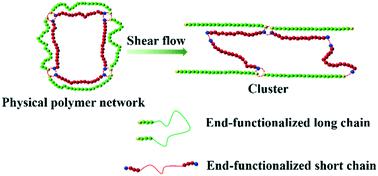当前位置:
X-MOL 学术
›
Mol. Syst. Des. Eng.
›
论文详情
Our official English website, www.x-mol.net, welcomes your
feedback! (Note: you will need to create a separate account there.)
Rheological and structural properties of associated polymer networks studied via non-equilibrium molecular dynamics simulation
Molecular Systems Design & Engineering ( IF 3.2 ) Pub Date : 2021-4-10 , DOI: 10.1039/d1me00017a Yuankun Peng 1, 2, 3 , Tongkui Yue 2, 3, 4 , Sai Li 2, 3, 4 , Ke Gao 2, 3, 4 , Yachen Wang 2, 3, 4 , Ziwei Li 3, 5, 6, 7 , Xin Ye 1, 2, 2, 3, 4 , Liqun Zhang 1, 2, 2, 3, 4 , Jun Liu 1, 2, 2, 3, 4
Molecular Systems Design & Engineering ( IF 3.2 ) Pub Date : 2021-4-10 , DOI: 10.1039/d1me00017a Yuankun Peng 1, 2, 3 , Tongkui Yue 2, 3, 4 , Sai Li 2, 3, 4 , Ke Gao 2, 3, 4 , Yachen Wang 2, 3, 4 , Ziwei Li 3, 5, 6, 7 , Xin Ye 1, 2, 2, 3, 4 , Liqun Zhang 1, 2, 2, 3, 4 , Jun Liu 1, 2, 2, 3, 4
Affiliation

|
An intensive understanding of the rheological and structural properties of polymer physical networks formed via associative functional groups of chain ends at the molecular level is still lacking. Herein, we employed coarse-grained non-equilibrium molecular dynamics (NEMD) simulation to explore the shear effect on this particular system. Firstly, we reproduced the shear thinning behavior of pure linear polymer chains. It was also found that the shear thinning behavior weakens and the corresponding zero-shear viscosity decreases for short polymer chains. Then we tailored the physical polymer network by varying the interaction strength between the end functional groups, and a prominent shear thinning behavior also occurs, attributed to the breakage of the physical network resulting from the chain alignment and orientation induced by the shear, and the physical network shows better integrity as the interaction strength between ending beads increases. Finally, we constructed end-functionalized polymer systems with bimodal molecular weight distribution, which showed that the shear viscosity and shear stress decrease with the proportion of the long chain, while the degree of the shear thinning is independent of it. At the same time, a large shearing force will destroy part of the physical network, but a small shear rate promotes the formation of the physical network. Generally, our simulated results may provide a molecular-level understanding of the structural and rheological properties of associated and bimodal molecular weight distribution polymers, as well as achieve efficient guidance for their molecular design and processing.
中文翻译:

通过非平衡分子动力学模拟研究相关聚合物网络的流变和结构性质
深入了解通过形成的聚合物物理网络的流变和结构性质在分子水平上仍缺乏链端的缔合官能团。在本文中,我们采用了粗粒非平衡分子动力学(NEMD)模拟来探索对该特定系统的剪切效应。首先,我们再现了纯线性聚合物链的剪切稀化行为。还发现短聚合物链的剪切稀化行为减弱并且相应的零剪切粘度降低。然后,我们通过改变末端官能团之间的相互作用强度来定制物理聚合物网络,并且还出现了显着的剪切稀化行为,这归因于剪切引起的链排列和取向导致物理网络的断裂。随着末端小珠之间相互作用强度的增加,网络显示出更好的完整性。最后,我们构建了具有双峰分子量分布的末端官能化聚合物体系,结果表明,剪切粘度和剪切应力随长链比例的增加而降低,而剪切稀化程度与之无关。同时,较大的剪切力会破坏物理网络的一部分,但是较小的剪切速率会促进物理网络的形成。通常,我们的模拟结果可以提供分子水平上相关和双峰分子量分布聚合物的结构和流变特性的了解,并为它们的分子设计和加工提供有效的指导。结果表明,剪切粘度和剪切应力随长链比例的增加而降低,而剪切稀化程度与之无关。同时,较大的剪切力会破坏物理网络的一部分,但是较小的剪切速率会促进物理网络的形成。通常,我们的模拟结果可以提供分子水平上相关和双峰分子量分布聚合物的结构和流变特性的了解,并为它们的分子设计和加工提供有效的指导。结果表明,剪切粘度和剪切应力随长链比例的增加而降低,而剪切稀化程度与之无关。同时,较大的剪切力会破坏物理网络的一部分,但是较小的剪切速率会促进物理网络的形成。通常,我们的模拟结果可以提供分子水平上相关和双峰分子量分布聚合物的结构和流变特性的了解,并为它们的分子设计和加工提供有效的指导。
更新日期:2021-05-06
中文翻译:

通过非平衡分子动力学模拟研究相关聚合物网络的流变和结构性质
深入了解通过形成的聚合物物理网络的流变和结构性质在分子水平上仍缺乏链端的缔合官能团。在本文中,我们采用了粗粒非平衡分子动力学(NEMD)模拟来探索对该特定系统的剪切效应。首先,我们再现了纯线性聚合物链的剪切稀化行为。还发现短聚合物链的剪切稀化行为减弱并且相应的零剪切粘度降低。然后,我们通过改变末端官能团之间的相互作用强度来定制物理聚合物网络,并且还出现了显着的剪切稀化行为,这归因于剪切引起的链排列和取向导致物理网络的断裂。随着末端小珠之间相互作用强度的增加,网络显示出更好的完整性。最后,我们构建了具有双峰分子量分布的末端官能化聚合物体系,结果表明,剪切粘度和剪切应力随长链比例的增加而降低,而剪切稀化程度与之无关。同时,较大的剪切力会破坏物理网络的一部分,但是较小的剪切速率会促进物理网络的形成。通常,我们的模拟结果可以提供分子水平上相关和双峰分子量分布聚合物的结构和流变特性的了解,并为它们的分子设计和加工提供有效的指导。结果表明,剪切粘度和剪切应力随长链比例的增加而降低,而剪切稀化程度与之无关。同时,较大的剪切力会破坏物理网络的一部分,但是较小的剪切速率会促进物理网络的形成。通常,我们的模拟结果可以提供分子水平上相关和双峰分子量分布聚合物的结构和流变特性的了解,并为它们的分子设计和加工提供有效的指导。结果表明,剪切粘度和剪切应力随长链比例的增加而降低,而剪切稀化程度与之无关。同时,较大的剪切力会破坏物理网络的一部分,但是较小的剪切速率会促进物理网络的形成。通常,我们的模拟结果可以提供分子水平上相关和双峰分子量分布聚合物的结构和流变特性的了解,并为它们的分子设计和加工提供有效的指导。











































 京公网安备 11010802027423号
京公网安备 11010802027423号